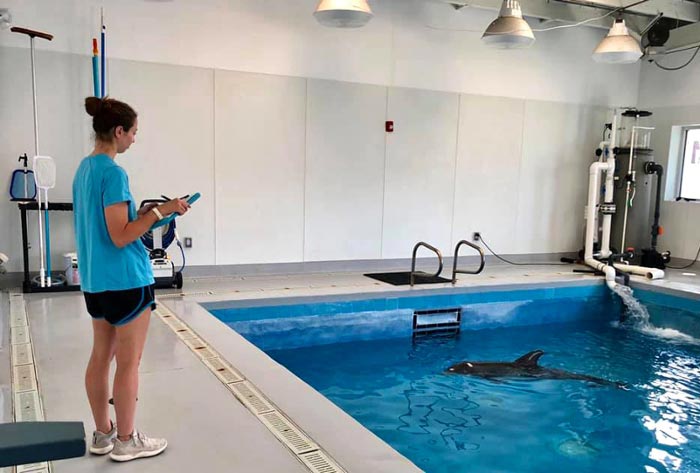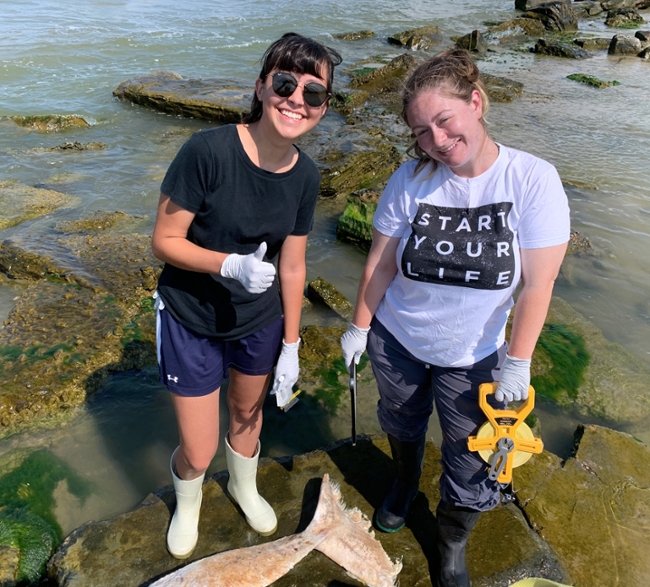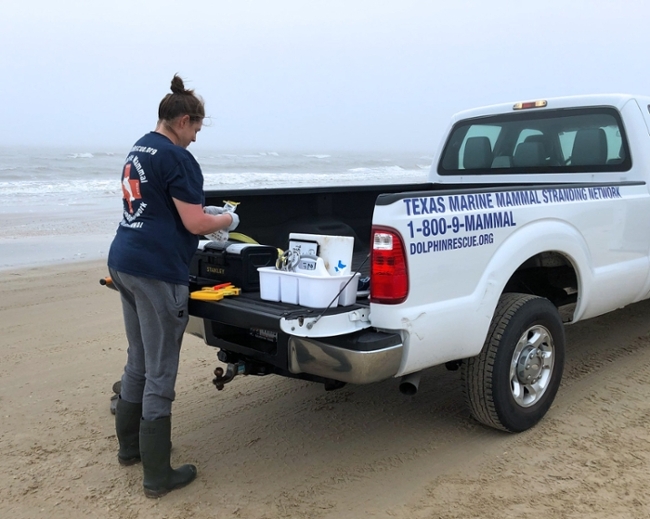A Galveston Dolphin Tale: TMMSN, TAMUG Relationship Ideal for Students & Animals
May 6, 2020
Tweet
By Andréa Bolt, Communications Specialist, Division of Marketing & Communications
The sun, sand and surf of Galveston Island are always favorite factors talked about by Texas A&M University at Galveston students. But for those in marine biology, fisheries or sciences degree programs, the access to marine life is crucial for research and study purposes.
Many of these same students seeking careers in the marine world find themselves looking for internship or volunteer opportunities close to home and the water. The Texas Marine Mammal Stranding Network (TMMSN) was happy to oblige and recently launched a new internship program ideal for Texas A&M-Galveston students to dive right in.
Since 1980, TMMSN has conducted marine mammal research along the Texas coast. Operating in conjunction with the National Marine Fisheries Service (NMFS), TMMSN also responds to live cetaceans—whales and dolphins—in need of assistance and works closely with the United States Fish and Wildlife Service (USFWS) for stranded manatees.
An Aggie by the sea herself, TMMSN Research Director Dr. Sarah Piwetz ‘18 said she was thrilled to be able to help the organization, support students and further research efforts by offering the program opportunity.
Interns Dive In
“As a volunteer-based organization, we really rely on that network, and while we’ve got an amazing core group of volunteers from all walks of life, we recognized the potential that an internship program could offer both to students and the TMMSN. We enjoy the relationship with Texas A&M-Galveston, and I know lots of students are interested in learning more, having more concentrated work and specific projects to focus on,” Piwetz said.
In the past year, four Texas A&M-Galveston students have served as interns. From helping to collect biological data from carcasses, record data on live animals in the wild or in rehabilitation, analyzing and digitizing historical records and more, students have gotten unique hands-on experience in the marine biology field from a very real-world perspective.
Mylasia Miklas ‘20 interned with TMMSN during her fall 2019 semester. As a marine biology student aiming to make a career of rescuing and rehabilitating marine mammals, the chance to work directly with such an organization was an “amazing opportunity” to help and learn.
Miklas digitized past patient data to help make more biographical information accessible and further research efforts. But she also got to help in observing and recording live data.

“If a live animal was at the facility, I participated in live animal observation shifts. During the shifts, I recorded the breathing rate and other notable behavior. I also had the opportunity to take part in necropsies (autopsies performed on deceased animals). I took notes, organized and labeled vials, and observed how to efficiently and accurately perform a necropsy, ” she explained.
Piwetz said she has taken special note of the work ethic Aggie by the sea students have displayed.
“I've been really impressed with their level of commitment. These students have a solid foundation and a solid understanding of how to collect, record and organize data. They’re so willing to jump in and learn.”
Such work helps TMMSN to diversify their data sets involving information gleaned from both live animals and recovered carcasses. Identifying facts like sex, length of the animal, body condition and organ samples help them to analyze the cause of strandings and how to best strategize to help future animals that might be in need.
Piwetz said she hopes to involve future interns in collecting more field-based data and environmental research.
“We also conduct research on the wild, free-ranging dolphin populations off Texas, including Galveston Bay, and we’d love to get interns involved in this type of data collection in the future," she said.
COVID-19 Affects
Piwetz said the best abundance estimates or population numbers for dolphins in Galveston Bay are currently approximately 851 in the winter and 1258 for the summer season. But with the interruption caused by the COVID-19 pandemic, coupled with recent poor weather conditions (i.e., high winds making boat-based dolphin research difficult) TMMSN hasn’t been able to get back out to study how they may be behaving relative to potential changes in Galveston Bay since pandemic restrictions were put in place.
Piwetz mentioned that there was reduced vessel traffic following the September 11 attacks that provided a sort of natural experimental setting for marine biologists in the Bay of Fundy, Canada.
“Shipping was halted at the time and research showed a decrease in baseline levels of stress-related hormone metabolites in North Atlantic right whales (tested via fecal samples) that was associated with a significant decrease in underwater noise (based on data from passive acoustic recorders),” she explained. There were also reports that the whales may have shifted their own acoustic communication to a more natural level in the quieter environment.
“It’s tough to say what effects there may be in connection with the pandemic. There is a reduction in dolphin tourism boats, three of which operate in Galveston, cruise ships and possibly reduced activity by cargo ships. However, there may be an increase in recreational boaters," Piwetz commented. "I did a study at Texas A&M-Galveston in 2015 in Bernd Würsig’s lab. We were looking at dolphin behavior relative to different vessel activity and found significant effects relative to dolphin tour boats and commercial shrimp boats.”

Piwetz is absolutely ready to get back out on the water and explore what the current conditions and the currents themselves have wrought.
“This shutdown came at a pretty heavy time for us, during our peak stranding season (December - April). With the vast reduction of beachgoers and the reduction in local services available at this time, we may see also see a shift in stranding reports,” Piwetz surmised. “We’re excited to get back out on the water and to hopefully put some new interns to work this summer, we’ll just have to wait and see what that will look like!”
###
Media contact:More:
Read more about Health & Environment
Read more about Science & Technology
Read more about Marine Biology
Read more about Marine Sciences
Read more about Student Life